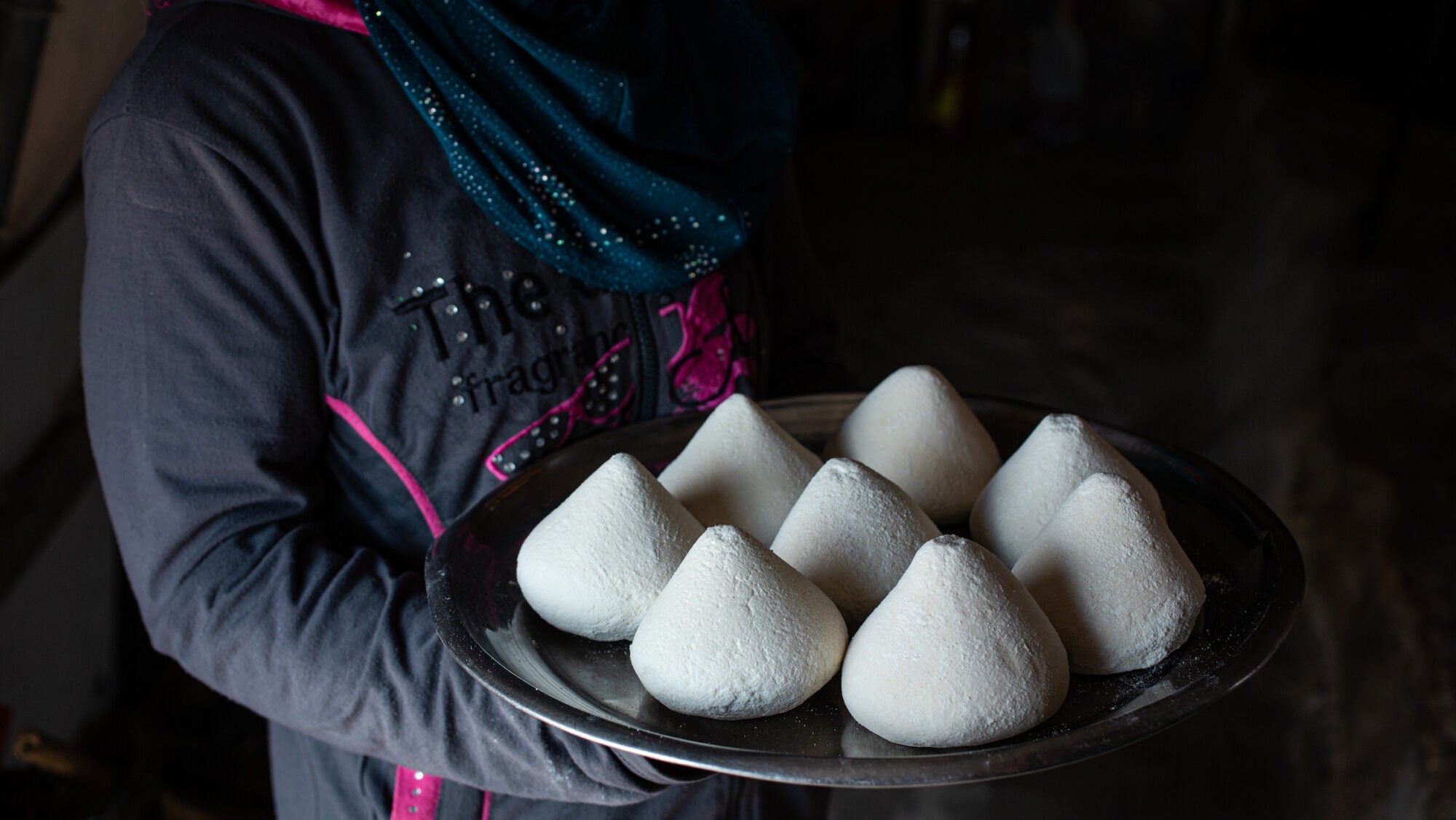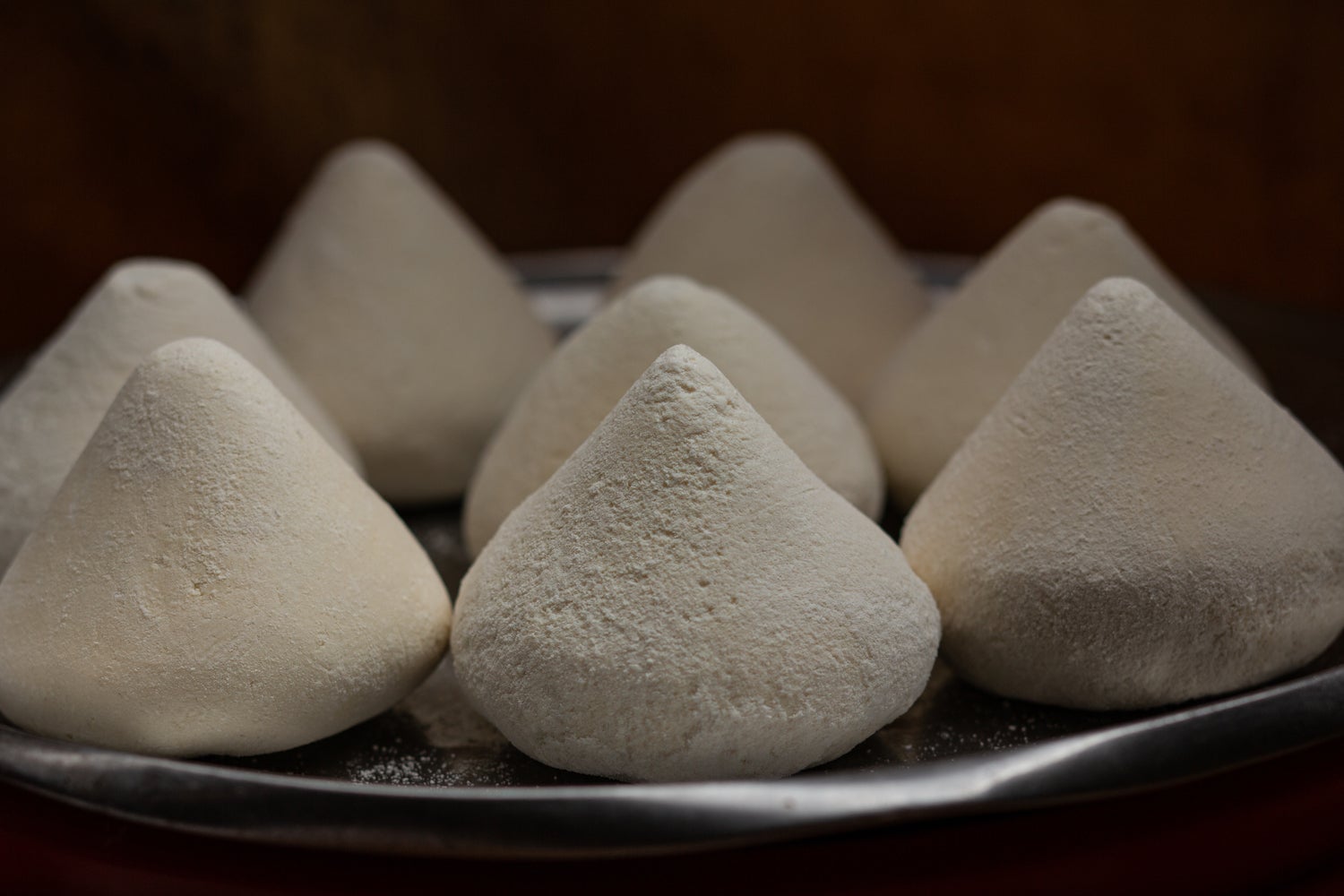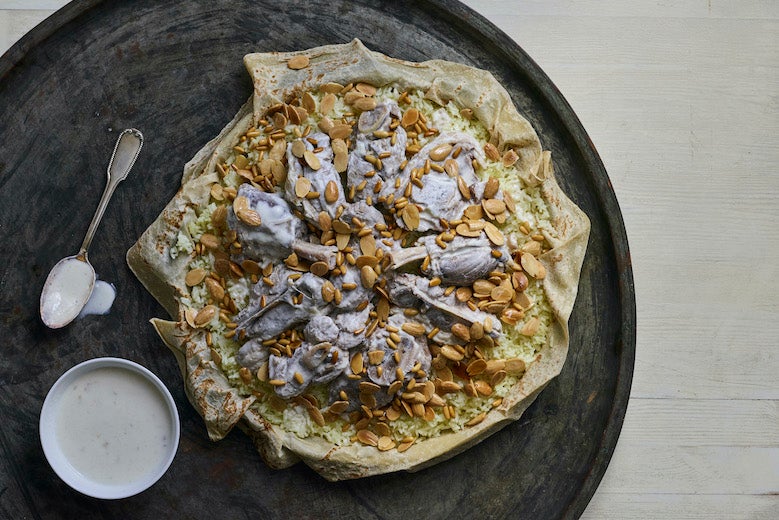
Yogurt, salt, and time are the key ingredients to jameed, a wonderfully savory staple of Palestinian and Bedouin cooking.
“Why is Khalto Ola hacking away at rocks with a giant knife?” I asked my mother this question one morning. We were in our neighbor’s kitchen, and I sat, mesmerized, watching this petite woman use what, to my five-year-old eyes, looked like a sword to turn the apple-size rock into thin shavings and powder.
Dismissing me after the hundredth question of the day as only mothers can so skillfully do, she told me it was jameed, not rocks, and went back to her conversation with her friend. And there I had it—my first encounter with the rocklike discs of dried yogurt used to add a deeply savory, sour intensity to the most traditional of Palestinian and Jordanian Bedouin dishes: mansaf.
Comparing the finished product to yogurt is like comparing a pickle to a raw cucumber.
Jameed dates back to the Middle Ages and has its roots in scarcity and the desire to preserve seasonal items from one year to the next. A by-product of soured milk that has been churned, boiled, strained, salted, and left out to air-dry for two to three weeks, it can keep for months, even years. While mansaf, bone-in lamb served on a heap of golden rice with warm yogurt sauce, may be jameed’s most recognized application, there are many uses for this extra hard cheese of sorts that can impart an intense flavor to anything it touches.
Bedouins are nomadic Arab people found across the Middle East who often tended large herds of sheep. When milk was plentiful in the spring, they would turn it into yogurt. This yogurt would then be whipped—by hand, in a churn made from sheepskin—to separate it into buttermilk and butter. The butter would be clarified into samneh, which lasted the year without refrigeration.

The buttermilk, on the other hand, would be heated again to separate the milk solids from the whey. The milk solids would be strained until they resembled a thick yogurt. That yogurt would be heavily salted and set aside for a couple weeks before being shaped into discs or cones that were left to air-dry completely—until they were as hard as a bar of soap. The longer they were left to dry, the harder and more durable they became. When salt emerged on the outside and could be dusted off, the jameed was ready, and it could keep for months, even years. Those dried in the shade retained a white color, while those dried in the sun took on a yellowish hue.
This traditional Bedouin food has made its way into many countries across the Arab world, from Saudi Arabia and Syria to Palestine and Jordan. It’s used to lend a variety of yogurt-based soups, stews, and dips a creamy texture and a uniquely acidic and salty flavor, like that of a hard, aged goat cheese but more sour.
To cook with jameed, you simply reconstitute it into yogurt by soaking it in water. The process takes much less time if it is broken up into smaller pieces, as my mother’s friend was doing that morning many years ago. Today’s abundance of dairy products might leave some wondering why they should bother with jameed if they can just buy yogurt anytime they want. But the flavor of jameed is far richer and more savory than plain yogurt, from the continued fermentation as it sits out for so long and from the intensely salty and concentrated yogurt flavor it takes on when drying. Comparing the finished product to yogurt is like comparing a pickle to a raw cucumber.

Commercial jameed can be found across the region nowadays, although the quality varies drastically. Even those produced by local artisans can vary in quality depending on how meticulous and hygienic the production process is and how long they were left to dry. When the discs are left to air-dry in the wild for weeks, how they are covered and tended makes a huge difference in the outcome. To this day, my mother gets her jameed from a family she has known in Ramallah since I was a child, and she will mail some to me wherever I happen to be living, insisting that the alternatives simply don’t taste the same.
Outside the Arab world, many Middle Eastern grocery stores carry jameed in its liquid form in Tetra Paks, and Persian markets also sell jarred liquid kashk, which is almost the same. But for many Arabs in the diaspora—from Turkey or Germany to Brazil or the United States, where I currently am—we choose to make a simplified version of it at home with just two ingredients: yogurt and salt! It takes about a week or so, but the process is relatively hands off.
Once you have this ingredient in your arsenal, its uses should not be limited to mansaf alone. Soaked and blended with some water to a yogurt’s consistency, jameed can form the basis for many a dip. I love one in which it is blended with fresh (or even roasted) tomatoes until smooth, and then crushed garlic fried in olive oil is poured in and mixed through. Straight out of the freezer (where I store my homemade jameed), jameed is like an Arab counterpart to Parmesan cheese, perfect grated over soups, salads, or manaqeesh (a pizza-like flatbread usually topped with za’atar).
Thanks to my Vitamix, I don’t need to spend my weekend mornings hacking away at solid rocks with a large knife, like our old neighbor Khalto Ola used to. But every time I make mansaf, or any dish in which I use jameed, I think back to that morning, to life’s simplicity back in those days, and I feel grateful that at least one element of it—even if in slightly different form—remains a staple in my kitchen today.